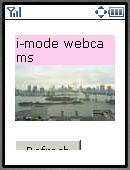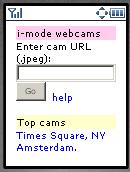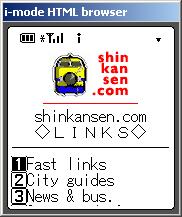I ran across a neat little mobile site called i-Mode Webcams which has links to fifty 
 or so webcams around the world – mostly cityscapes and street scenes. Handy if you want to check the weather across the world or across the city. The images are scaled down to 120 pixels wide by default so they should work on just about any WAP2 phone. You can also specify a different width if your phone has a larger screen. You can even enter the url of any other webcam you happen to know of and view it on your mobile.
or so webcams around the world – mostly cityscapes and street scenes. Handy if you want to check the weather across the world or across the city. The images are scaled down to 120 pixels wide by default so they should work on just about any WAP2 phone. You can also specify a different width if your phone has a larger screen. You can even enter the url of any other webcam you happen to know of and view it on your mobile.
Content: ![]()
![]()
![]()
![]() Usability:
Usability: ![]()
![]()
![]()
![]()
![]() html i-Mode
html i-Mode
The fact that this was an i-Mode site, lead me to do a bit of research into the whole i-Mode phenomenon. One of the first things I Googled was a fascinating article in annoying PDF format about i-Mode at www.ion-global.com, a multinational web (including mobile) development and marketing company. I’ve never heard ion-Global before and don’t know anything about them, but the article seems well researched. I coraborated most of the facts and dates at two other excellent i-Mode sites, NTT DoCoMo’s official i-Mode marketing page and the Unofficial independent i-Mode FAQ. For someone who writes about the mobile web, I know far too little about i-Mode. Like everyone, I’ve heard it’s great, that in Japan you see everyone browsing away on their phones, etc. I’ve also heard that the success of i-Mode is probably a uniquely Japanese phenomenon because of cultural and economic differences including the relatively high price of wired telephone and Internet service in Japan. Well, after reading the article, I wasn’t so sure that Western mobile developers, marketers and carriers couldn’t learn a thing or two from i-Mode.
i-Mode in Japan is probably the most successful mobile Internet platform in the world in terms of the level of adoption and frequency of use by it’s subscribers. Launched in Japan in 1999 by NTT DoCoMo, one of the three Japanese mobile service providers, i-Mode which is only available from DoCoMo now has over 43 million subscribers representing 90% of DoCoMo’s 49 million subscribers. Japan has a population of less than 130 million people and amazingly around 89 million active cellular phones.
Based on a simplified form of html called cHTML, i-Mode is easy to develop for and was quickly adopted by independent and hobbyist developers. From the beginning i-Mode was a success and played a major role in driving DoCoMo’s market share to 59% in 2001. The other two Japanese providers are KDDI and Vodaphone controlled J-phone. In response to i-Mode, KDDI created an HDML! based mobile browsing platform called EZ-Web while J-Phone rolled out J-Sky, using it’s own html based MML (mobile markup language) which is similar to but not totally compatible with i-Mode. i-Mode was so much more popular than EZ-Web that KDDI launched an iMode to hdml transcoder so it’s users could access i-Mode sites. Eventually, all three providers added xhtml-basic or xhtml-mp support to their browsers. However, even today the majority of Japanese mobile sites are i-Mode. Fortunately, most WAP2 phone browsers can display most i-Mode sites providing a degree of interoperability. As their mobile web platforms have matured J-Phone and especially KDDI have started to cut into DoCoMo’s market with the current percentages being DoCoMo 56%, KDDI 27% and J-phone 17%.
Services that are considered innovative in the US and Europe like mobile payment, banking and location based services are common and taken for granted in Japan having been in wide use for several years. The use of the mobile web to access driving directions, maps and transit schedules is commonplace as is mobile stock trading, biding on online auctions and shopping. Mobile email is ubiquitous in Japan. It’s not surprising that 80% of Japanese business subscribers use mobile email – most businesses now run forwarding servers that allow employees to view corporate email on handsets from all three providers. More telling is that 90% of Japanese teenagers use mobile email. The providers also include very popular web based PIM services as a part of the standard data package.
The types of sites that are popular in Japan are not much different than what is popular on the US and European mobile web. According to DoCoMo, entertainment sites are most popular followed by email, news, weather, transit information, traffic reports, banking, restaurant information, fortune telling, dating and TV guides.
There is an important distinction between Official and non-official i-Mode sites. Official sites have been vetted by the carrier and agree to a code of conduct which is rather restrictive – prohibiting not only porn but even dating and chat sites. In return official sites get a listing in the carrier’s online directory and the ability to make secure transactions and add the charges to the users cellular bill. On KDDI official sites can even access the users location as reported by the phones GPS. The barriers to becoming an official site are much lower than they are to becoming a content providing partner of a US carrier. DoCoMo collects a very reasonable 9% commission on charges passed through it’s system. This model seems to be a success as DoCoMo has over 4,400 official sites.
Unofficial sites, on the other hand are independent mobile sites that anyone can create. There are no restrictions other than legal ones and the carriers do not block users access to any site. The over 70,000 unofficial sites now account for over 50% of the total traffic. As unofficial sites aren’t listed in the carrier’s portal, users used to have to enter the url or find the site using a search engine. Recent i-Mode camera phones can read and open a url from a special barcode called a QR code. QR codes are published in magazines and on fliers. QR codes are also starting to appear on Japanese business cards – when scanned with a camera phone the contact information in the barcode is added to the phone’s address book.
So why is the mobile web and particularly i-Mode so popular in Japan. There are many factors such as the high cost of both dial-up and broadband wired Internet. In 1999, when i-Mode was launched, only 23% of Japanese had access to the Internet by computer – the phone became their computer. Home computers are still less common in Japan than in the US and Western Europe and are perceived as hard to use compared with the simplicity of i-Mode! So how is it that Japanese find i-Mode easy to use and most Westerners believe that WAP is frustratingly difficult? If you look at the relatively few i-Mode sites that are in English, you will be surprised at how dull and sparse they look. There are several reasons for this. For one, almost all the graphics in i-Mode are provided by emoji, a collection of over 200 small icons that are resident in the handset’s ROM and thus don’t appear if you aren’t using an i-Mode browser. Cost is another factor. i-Mode has traditionally been a metered service and rates are high by Western standards, .20 Yen per 128 byte packet (about 2 cents per KB) although unlimited data plans have recently been introduced at around 4000 Yen ($33.20) per month. As high as these rates appear, they are cheap compared with the cost of making a phone call which is around 80 cents per minute (incoming calls are free). Keeping i-Mode pages small and task oriented makes i-Mode cost effective. Checking a train schedule or sending an email with i-Mode costs less than 5 US cents. Finally, i-Mode pages seem designed for utility rather than flashiness, i-Mode developers, who probably use i-Mode daily themselves, must know that unless a page is easy and inexpensive to use it will not get traffic.
i-Mode is not only in Japan. DoCoMo has been trying to spread the technology worldwide with alliances and investments in mobile operators around the world. Adoption outside of Japan started slowly but seems to be gathering momentum, KPN in Holland, BASE in Belgium, E-Plus in Germany, Bouygues in France, Telefonica in Spain, Wind in Italy COSMOTE in Greece, Telestra in Australia and O2 in Great Britain have all launched i-Mode services – in most cases as an optional alternative to their existing WAP services. Initially, i-Mode email was a big selling point for these new services as there were few European i-Mode sites. i-Mode seems to be growing in Europe although slowly. In February, 2004 KPN celebrated their millionth i-Mode subscriber as well as 400 official content providers. Of course, it was the discovery of an interesting European site that led to this article.
I think the European experience has proven that i-Mode’s level of success can not be duplicated onside of Japan. However I believe that some of the factors that made i-Mode such a success in Japan can be productively applied to the mobile web anywhere. Particularly:
- Low barriers of entry for content providers. Carriers need to make it easy for independents to create sites and get them into the carriers portal.
- The ability to make secure transactions and access location data, while obviously needing to be restricted, should be available to trustworthy partners without onerous red-tape and excessive commissions.
- Mobile pages should emphasize utility and ease of use.
- Using data rather than voice for simple messaging and information retrieval should be less expensive than making a voice call.
OK, so you want to see some i_mode in action.  A good place to start is http://www.shinkansen.com an English language i-Mode portal with dozens of links to English i-mode sites in Japan. i-Mode, because it is mostly a subset of HTML will display reasonably well in IE, Firefox and Opera as well as most WAP2 browsers. You won’t see the emoji, instead you will get a question mark, little box or nothing at all where the emoji should appear. The latter is a problem as most links in i-Mode are on just the emoji not the text following it. The only browser that I’ve seen that strips emoji completely – thus removing the links is the Access Netfront browser used on some Sprint Sanyo handsets. Fortunately, most English i-Mode sites make very limited use of emoji. If you want you can download the DoCoMo iMode simulator and see i-Mode sites as they should look. There is also a good online emulator at http://pukupi.com/tools/mimic/
A good place to start is http://www.shinkansen.com an English language i-Mode portal with dozens of links to English i-mode sites in Japan. i-Mode, because it is mostly a subset of HTML will display reasonably well in IE, Firefox and Opera as well as most WAP2 browsers. You won’t see the emoji, instead you will get a question mark, little box or nothing at all where the emoji should appear. The latter is a problem as most links in i-Mode are on just the emoji not the text following it. The only browser that I’ve seen that strips emoji completely – thus removing the links is the Access Netfront browser used on some Sprint Sanyo handsets. Fortunately, most English i-Mode sites make very limited use of emoji. If you want you can download the DoCoMo iMode simulator and see i-Mode sites as they should look. There is also a good online emulator at http://pukupi.com/tools/mimic/
Developing for i-Mode The official DoCoMo i-Mode developers site in English is the best place to start. Note that all three Japanese providers are recommending the use of xhtml for new sites. The site has loads of documentation on i-Mode including specifications of the various technologies that make up i-Mode such as xhtml, cHtml, iappli which is a Version of Java ME, Flash, multimedia, email, security, barcode and ringtone protocols and a list of emoji with their character codes and what they mean. The DoCoMo site also has a wealth of downloadable tools to support development of all of the above.
More References:
Japan cellular subscriber update (pdf)
Time-Asia: Deflating DoCoMo
IBM: i-mode – From bandwidth problem into Internet phenomenon
Build your own i-mode site fast and simple
How to create an i-mode site (pdf)
wont be long before porn sites like mobilebabes.com get a hold of this technology on wap or imode i guess
Maria,
I did a quick Google for i-appli download sites and didn’t find much which surprised me.
You don’t say what languages your i-appli is localized for but here are a couple of Japanese sites:
http://www.hudson.co.jp/mobile/eng/jp/imode/iapp/index.html
http://www.tsukuda-2.com/pc/
And here is a list of European i-mode portals (although none seem to be offering downloads).
http://www.palowireless.com/imode/portals.asp
Thank you for the useful article! Actually we are the developer of IM Instant Messenger application for i-mode. Does anybody know a good list of non-official i-mode sites to submit this i-appli?
Regards,
Maria
I stumbled across this article on cool business ideas.
Looks like we still have a whole new world of mobile technology and WAP to discover! I’ve pasted the article here. You can explore more on the website.
Tag it and Share!
Trendwatching.com: Codes for consumers, not producers, is one thing, but in an open source, CUSTOMER MADE world, what about codes by consumers? Check out Singapore based Tagit, who have developed a universal decoding engine which runs on an open platform, meaning that all types of digitized codes, from the QR Code and the humble 2D DataMatrix to Tagit’s own proprietary Tagit.Code can be decoded. But that’s not all: the DIY side of the business is Tagit’s KoolTag: “You can create a KoolTag for any message you want to communicate to your friends. If you want your girlfriend to see a special secret image, or if you want to share a private video clip with your friends, all you need to do is to create a KoolTag on this site, print it out, email it or just stick it on a t-shirt to attract attention. All that’s needed is a cameraphone to capture the KoolTag which lets you see the private content. KoolTag is free!”
INFOLUST [Trendwatching.com]
Pingback: Sumedh Mungee